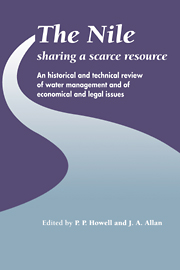 The Nile: Sharing a Scarce Resource
The Nile: Sharing a Scarce Resource Book contents
- Frontmatter
- Contents
- Preface
- List of Contributors
- Orthography
- Units and Conversion Factors
- Introduction
- I Environmental history of the Nile and its management
- II Nile management and factors affecting future management
- III Future utilisation of Nile waters
- 8 Future irrigation planning in Egypt
- 9 Future water development planning in the Sudan
- 10 Irrigation and hydro-power potential. Water needs in Uganda, an overview
- 11 The integrated development of Nile waters
- 12 The control of the swamps of the southern Sudan: Drainage schemes, local effects and environmental constraints on remedial development
- 13 Water balance of the Bahr el Ghazal swamps
- IV Economic, international and legal issues
- Index
10 - Irrigation and hydro-power potential. Water needs in Uganda, an overview
Published online by Cambridge University Press: 05 February 2012
- Frontmatter
- Contents
- Preface
- List of Contributors
- Orthography
- Units and Conversion Factors
- Introduction
- I Environmental history of the Nile and its management
- II Nile management and factors affecting future management
- III Future utilisation of Nile waters
- 8 Future irrigation planning in Egypt
- 9 Future water development planning in the Sudan
- 10 Irrigation and hydro-power potential. Water needs in Uganda, an overview
- 11 The integrated development of Nile waters
- 12 The control of the swamps of the southern Sudan: Drainage schemes, local effects and environmental constraints on remedial development
- 13 Water balance of the Bahr el Ghazal swamps
- IV Economic, international and legal issues
- Index
Summary
Introduction
This brief contribution to the debate on the utilization of the Nile aims to highlight the technical information available on Uganda's water requirements in relation to that river.
Uganda, with its total land area of 236,810 km2, lies wholly in the White Nile Basin. The country's hydrology is dominated by the River Nile and its associated lake system. Open water covers 36,278 km2 or 15 per cent of the land, and another 5,183 km2 or 2.2 per cent is covered by swamps. To Uganda, therefore, the Nile is not only a source of water for all sectors of the economy, but the environment upon which everything depends.
Socio-economic factors
Uganda's economy, like that of most third-world countries, is heavily dependent on the export of raw materials – mainly coffee – for which prices on the world market have been decreasing over the past decade, while it imports finished goods and services at ever increasing prices. The population, currently estimated at sixteen million, is increasing at a high rate close to four per cent per annum which is putting great pressure on the land and other natural resources, including water.
In addition to the irrigation potential, the Nile system offers Uganda a great source of hydro-electric power for its domestic needs and for export. Although Uganda is less rich in mineral deposits such as gold and petroleum, it has a large natural resource in water, and it is on this that its future socioeconomic development will depend.
- Type
- Chapter
- Information
- The Nile: Sharing a Scarce ResourceA Historical and Technical Review of Water Management and of Economical and Legal Issues, pp. 217 - 226Publisher: Cambridge University PressPrint publication year: 1994
- 1
- Cited by


